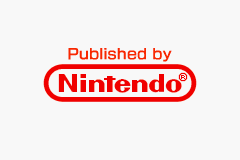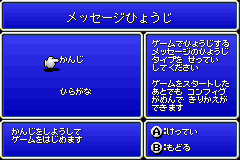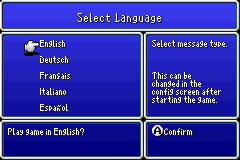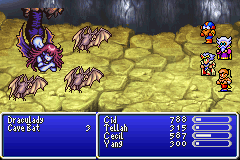Final Fantasy IV Advance/Version Differences
This is a sub-page of Final Fantasy IV Advance.
Regional Differences
Some minor localization changes were made when the game was released in different regions. Note that the Australian version is identical to the North American version.
| North American | European |
|---|---|
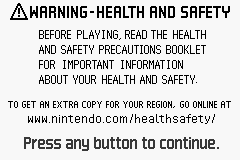 |
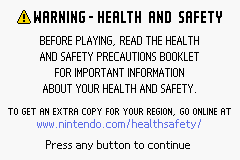 |
The North American and European versions both display their region's respective health and safety warning screen upon starting the game. One was not present in the Japanese version.
The North American and European versions also display a "published by Nintendo" screen before the Square Enix logo, which is not present in the Japanese version because Square Enix published the game in Japan.
This menu is shown when starting a new game in the Japanese version. It allows you to choose whether or not to use kanji characters. This was the first version of Final Fantasy IV to use kanji in its script. The prologue text is also affected by this choice, and will use the game's large font when kanji is enabled, as opposed to the small font. The other versions always use their small font for the prologue text.
A similar menu is shown upon starting the European version of the first time. It allows you to select which of the five languages you want to play the game in. The North American version can only be played in English.
| North American | Japanese | European |
|---|---|---|
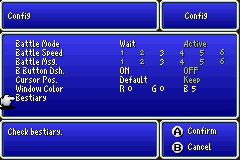
|
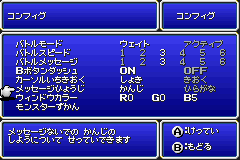
|
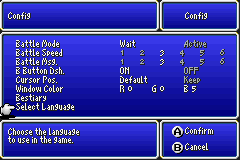
|
In either version, this choice can be changed at any time through an option in the config menu. There is a blank space in the North American version's menu due to the removal of these options.
| North American | European |
|---|---|
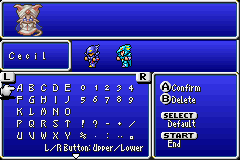 |
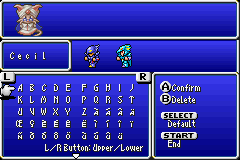 |
The additional letters available in the European version were added to Namingway's screen. When this was done, the layout of the letters was changed from being placed in the lefthand column (as was also the case for English input in the Japanese version) to spanning both columns.
Character names in the North American version use a different, wider set of capital letters than the rest of the text in the menus. This was changed in the European version and names now use the same letters as the rest of the text.
The Japanese version allows switching between three sets of characters: Hiragana, katakana, and capital English letters and punctuation marks.
| North American | European |
|---|---|
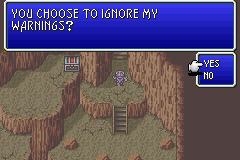 |
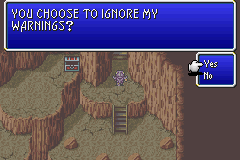 |
The Yes/No prompts displayed in certain events used all caps in the North American version. They were changed to being properly cased in the European version.
| North American | European |
|---|---|
| Do not defy the king, or you will end up like Kain. |
Do not defy the king, or you will end up like Cid. |
Upon returning to Baron after Cecil becomes a paladin, the man outside warns about ending up like Kain if you defy the king in the North American version. Despite making sense from a plot standpoint, this was actually a name code mistake - Cid's name was supposed to be used here. This was corrected in the European version.
| Japanese | North American, European |
|---|---|
 |
 |
The dancer sprites were altered to always wear a dress in the North America and European versions. In the Japanese version, all dancers wear swimsuits with the exception of the one in Baron, who wears a dress but tosses it aside when she dances. Some of the shopkeepers in Troia also wear dresses, but in both cases only the downward facing sprites were needed. The unaltered sprites are still present in the ROM, and these altered ones are loaded in place of them. Amusingly, the dancer in Baron was altered by merely blanking out the tossed dress graphics.
The ギルガメ (girugame) enemy was mistranslated as Gilgamesh in the North American version. Yes, everybody's favorite incompetent lackey from Final Fantasy V was reduced to a mere turtle. This mistake was caught and it's correctly called the Gil Turtle in the European version.
Revisional Differences
The original North American and Japanese versions of the game, released a few days apart, suffered from numerous bugs and oversights. As mentioned above, the Australian version is identical to the North American version, despite coming out months later. Many issues were corrected in the European version, and later a 1.1 release was made in Japan with these fixes. Unfortunately, this revision was never released stateside or down under.
| To do: Needs screenshots or videos where appropriate. Could probably be formatted better, too. |
- Monsters which are hatched from a Mystery Egg aren't counted as kills for the bestiary.
- The treasure chest containing Porom's Nirvana Staff in the Lunar Ruins has a chance of freezing the game.
| To do: See if this applies to Japan. Move to regional if not. |
- The reptile monster type is mistakenly called insect in the bestiary.
- Yang's maximum HP stops increasing after level 60. This originated in the SNES versions, but had no real impact there since Yang was lost about mid-way through the game.
- Randomly, yet commonly, an extra turn might be granted immediately after taking an action in battle. This one is most visible with players due to the addition of an ATB gauge, but it affects monsters as well. In some cases, this can prevent another character or monster from being able to act at all.
The Draculady and Miss Vamp monsters mentioned were drawn so that they would always be attached to the top of the screen in battle. Likely as a result of centering enemy positions based on coordinates from the WSC version, which had a lower resolution screen, these monsters instead "float" eight pixels below the top of the screen, which looks silly. The Echidna monster, new to this version of the game, also suffers from this problem.
- Certain weapons are flagged to ignore the damage and accuracy reduction inflicted by their wielder being in the back row. The original versions of the game ignore this bit and apply the penalty anyway. Instead of fixing this for the European and Japanese 1.1 versions, the opposite behavior is used, and no weapons, with the exception of bows and arrows, are penalized. Bows and arrows are always penalized, in spite of the fact that they have the long range bit set.
- Cagnazzo and Barbariccia are both supposed to obtain increased evasion at certain points during their battles. Cagnazzo when he retreats into his shell, Barbariccia when she spins. The evasion boost is never applied.
- Weapons starting from index $120 on are mistakenly treated as armor in the original versions of the game, and as a result their elemental, status, and monster type attack multipliers are treated as resistances. This affects the following weapons:
- Asura's Rod - Holy
- Tiger's Fangs - Paralysis
- Dragon Claw - Holy, Dragons
- Loki's Lute - Dragons, Mechs, Reptiles, Ghouls, Giants, Mages, Undead
- Mist Whip - Holy, Paralysis
- Assassin Dagger - Death
- Piggy's Stick - Piggy
- Rising Sun - Aerial
- Requiem Harp - Drain
- Gigant Axe - Poison
- Perseus Bow - Aerial
- Player input while targeting monsters in certain formations is handled somewhat oddly, and can even prevent monsters in the center of formations from being targeted at all. In particular, this affects one of the newly added boss monsters, Master Flan. In the original releases, you had to kill one of the flan monsters surrounding Master Flan in order to target it. In the European and Japanese 1.1 versions, it can be targeted directly. Since the battle is requires you to kill Master Flan while he regularly summons more flan monsters to replace the ones you've killed, it seems likely that the targeting fix actually broke the intended behavior of this one specific battle, while it fixed others.
- During the automatic battle between Tellah and Edward, Tellah will often miss. Unlike the SNES version and corrected GBA versions, misses will not advance the battle. This can prolong the battle for a ridiculous amount of time, since Tellah is more likely to miss than actually land a hit.
